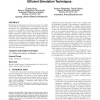Free Online Productivity Tools
i2Speak
i2Symbol
i2OCR
iTex2Img
iWeb2Print
iWeb2Shot
i2Type
iPdf2Split
iPdf2Merge
i2Bopomofo
i2Arabic
i2Style
i2Image
i2PDF
iLatex2Rtf
Sci2ools
EMSOFT
2004
Springer
2004
Springer
Separation of concerns: overhead in modeling and efficient simulation techniques
Separating the description of important aspects of a design such as behavior and architecture, or computation and communication, may yield significant advantages in design time as well as in re-usability of the design. However, exploiting fully the re-usability opportunities offered by this approach implies to keep the various aspects of the design separated rifying the design at a given level of abstraction. In particular, simulation of the design may undergo significant overhead versus a traditional approach where the design is represented and analyzed monolithically. In this paper, we present a few techniques that eliminate almost entirely the overhead while maintaining the positive aspects of the separation of concerns. Experimental results on a complex design back this assertion. Categories and Subject Descriptors D.2.4 [Software/Program Verification]: Validation General Terms Design, Verification, Performance Keywords Platform-based Design, Orthogonalization of Conerns, Simulati...
Related Content
| Added | 20 Aug 2010 |
| Updated | 20 Aug 2010 |
| Type | Conference |
| Year | 2004 |
| Where | EMSOFT |
| Authors | Guang Yang 0004, Alberto L. Sangiovanni-Vincentelli, Yosinori Watanabe, Felice Balarin |
Comments (0)

